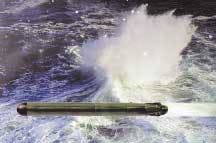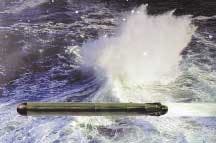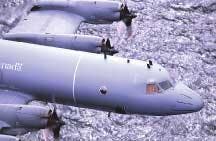Enabling technologies for military and aerospace electronics designers
Board products
Raytheon picks Radstone for torpedo
Engineers at Raytheon Integrated Defense Systems in Tewksbury, Mass., needed a digital signal processor (DSP) for the U.S. Navy MK-48 Advanced Capability (ADCAP) torpedo upgrade program. They found an answer at Radstone Technology PLC of Towcester, England.
The MK-48 ADCAP torpedo is a submarine-launched, wire-guided, thermal weapon against submarines. Raytheon designers are upgrading its technology in a joint program with engineers at the Naval Undersea Warfare Center (NUWC) in Portsmouth, R.I.
Raytheon planners awarded the $4.5 million contract to Radstone for ruggedized COTS (commercial off-the-shelf) PowerPC G4 DSP and PowerPC processors. The new electronics will boost torpedo performance in guidance, control, speed, and memory, and will significantly reduce radiated noise, Raytheon officials say.
This production contract is Phase 8 of the upgrade program and follows a Phase 7 contract awarded to Radstone in 2002.
"Radstone's G4 DSP rugged digital signal processor is an ideal match to the requirements of the system and is further demonstration of Radstone's growing emergence as a major DSP supplier," says Peter Cavill, Radstone's managing director.
For more information, contact Radstone Technology online at www.radstone.com.
Power electronics
General Dynamics picks Ultralife batteries for Land Warrior
Designers at General Dynamics C4 Systems in Taunton, Mass., needed a battery for the U.S. Army's Land Warrior–Stryker Interoperable (LW-SI) program. They found a supplier in Ultralife Batteries Inc. in Newark, N.Y.
Land Warrior is an integrated soldier system that includes everything an infantry soldier would wear or carry on the battlefield, including computers, lasers, geolocation, and embedded voice- and data-communications equipment. These combined capabilities will enhance each soldier's close combat tactical awareness, lethality, and survivability.
Under the $2.7 million development contract, Ultralife will develop nonrechargeable lithium primary and rechargeable lithium-ion batteries. The new batteries will power communications devices and other parts of the system.
Company officials say they plan to deliver the first batteries for the program by January 2005.
Ultralife also supplies BA-5390 batteries to the U.S. Army to power backpack radios and weapons sights. For more information, contact Ultralife Batteries online at www.ultralifebatteries.com.
Communications equipment
Boeing picks Smiths Aerospace for 7E7 avionics and networking
Engineers at Boeing in St. Louis needed an open-architecture networked avionics system for the future 7E7 Dreamliner passenger jet. They found a solution at Smiths Aerospace in London.
Boeing designers tapped Smiths to build the 7E7's common core system, an integrated avionics platform that uses remote data concentrators instead of the traditional dedicated signal wiring.
The concentrators link sensors and effectors of each system to a shared modular computing resource through an advanced communications network, shaving thousands of pounds in weight.
"By reducing wiring and consolidating computing resources, the common core system helps the 7E7 achieve a 20 percent reduction in fuel use," says Boeing 7E7 Senior Vice President Mike Bair. "This leads to the 7E7 being a better airplane for the environment and a less expensive airplane to operate."
The 7E7 is scheduled to carry its first paying passengers in 2008.
Smiths also builds components for Boeing military and commercial aircraft such as flight-management systems, landing-gear actuation and hydraulic systems, flight controls, electronics, fuel-management systems, primary and secondary power distribution, avionics systems, and airframe structural components. For more information contact Smiths Aerospace online at www.smiths-aerospace.com.
Board products
General Dynamics chooses Primagraphics to display sensor data on CP-140
Engineers at General Dynamics Canada in Ottawa needed a way to sort data from several sensors onto displays aboard the CP-140 Aurora long-range maritime patrol aircraft. They found a solution at Primagraphics in Charlottesville, Va.
Under a $300,000 contract, engineers at Primagraphics will supply a VME Cobra quad video windows card to handle the video signals from optical and infrared sensors at each display console on the aircraft.
The card will also help to switch and scale the signals for display in windows with a high-resolution graphics overlay.
Under a contract from Canada's Department of National Defense, General Dynamics Canada is responsible for the supply and integration of a new data- management system for the CP-140 as part of the Aurora Incremental Modernization Project (AIMP).
They chose the COTS Cobra card because it accepts red-green-blue, TV, and special-format interlaced video signals, and uses four independent video scalers to support a multi video display.
The card is for applications that must display several video and graphics signals simultaneously, for applications in command and control systems, training and simulation, as well as in surveillance, reconnaissance, and homeland security.
"Cobra is our latest high-performance video windowing product and provides an excellent platform for sensor-rich surveillance and reconnaissance applications due to its quad window capability and the separate graphics channel," says Primagraphics Product Manager David Johnson.
For information, contact Primagraphics at www.primagraph.ics.com.
Computers
Hawaiian police choose vendors to handle fingerprint and mug-shot data
Police in Kauai, Hawaii, needed a way to handle bulk data for fingerprints and mug shots to reduce their data entry and accelerate booking and investigation. They found a solution with the team of ImageWare Systems Inc. in San Diego and SAGEM Morpho Inc. of Tacoma, Wash.
To create the new platform, designers will incorporate ImageWare's image-capture technology into SAGEM's integration livescan system (ILS2).
When completed, police officers will be able to capture digital mug-shot images, fingerprints, and palm prints all from one booking station. They will also be able to search the database to build lineups and mug books automatically.
All images will be stored in a central data repository hosted by the Hawaii Criminal Justice Data Center on the Island of Hawaii. That center already has implemented a similar system for police departments in Hilo and Kona so police across the state can share investigation reports.
"We are very pleased to have the opportunity to assist in the advancement of Kauai's law-enforcement identification technology," says Jean-Marc Suchier, chief executive officer of SAGEM Morpho. "SAGEM's ILS2, coupled with ImageWare's image-capture technology, provides a seamless multibiometric capture system that will improve Kauai County's criminal booking process."
"Real-time data sharing is a vital component to the law-enforcement community," says Joe Schuler, senior vice president of sales and marketing for ImageWare. "The ability to share mission-critical information facilitates the investigative process and supports criminal-justice services more efficiently."
For more information, contact ImageWare Systems online at www.iwsinc.com, or SAGEM Morpho at www.morpho.com.
Sensors
U.S. Army chooses team for video surveillance around bases
U.S. Army planners needed a surveillance and security system to help guard military bases. Their prime contractor, Management Systems Designers of Vienna, Va., awarded the job to the team of videoNEXT, also of Vienna, Va., and RemoteReality, in Westborough, Mass.
The challenge was to improve local- and wide-area perimeter security using the existing network and new hardware, without increasing the security staffing requirements.
Engineers at RemoteReality supplied OmniTrack cameras and immersive viewing systems, while engineers at videoNEXT provided NEXTcam servers and software to control and monitor the surveillance network.
By combining those tools, Army security staff can monitor site perimeters, wide fields, parking lots, and entryways. Fiber-optic lines combine video feeds from cameras miles apart. The data then flows into their legacy intrusion-detection system, so they can control the entire system on one computer.
"We see ourselves as bringing the brains to control and monitor the system," says Chris Gettings, chief executive officer of videoNEXT. "But without the immersive viewing capabilities of RemoteReality's OmniTrack, we would not have the eyes.
"It's a powerful partnership for delivering the best in immersive video across distant, isolated networks," Gettings continues. "This job for the Army is a classic example of how together we can improve homeland security through centralized monitoring."
For information, contact videoNEXT at www.videonext.com, or RemoteReality at www.remotereality.com.
Displays
United Kingdom airline chooses cockpit security from AD Aerospace and AEI
Designers at the British passenger airline Thomsonfly needed a security system to monitor their cockpit doors in flight. They found an answer at AD Aerospace of Atlanta, Ga.
Many airlines have installed intrusion-resistant cockpit doors to protect their pilots from terrorism and air rage during flights, yet that approach also isolates the pilots, making them unaware of events in the cabin.
To solve the problem, designers at AD Aerospace make FlightVu, a cockpit door- monitoring system (CDMS) designed for the Boeing 737-500 jetliner. FlightVu uses three closed-circuit television cameras linked to a liquid-crystal display in the cockpit pedestal.
The cameras are hidden throughout the cabin in flush-mounted, color-coordinated housings, and use infrared illuminators to provide pictures whether the cabin lights are on or off.
"The cockpit monitor gives our pilots a clear view of the area outside the door so they are aware of anything occurring,'' says Richard Perkins of Thomsonfly, which operates out of Coventry Airport, England.
Other commercial airlines using the system include Astraeus, bmi, Britannia, easyJet, FlyJet, GB Airways, Hapag Lloyd, and MyTravel. AD Aerospace will partner with Aircraft Engineering & Installation Services Inc. (AEI) of Orlando, Fla., to install the equipment.
For more information, contact AD Aerospace online at www.ad-aero.com.
Components
Dragonfly picks Metal Storm to arm UAV
Engineers at Dragonfly Pictures Inc., Essington, Pa., needed to add weapons to their Dragonfly DP-4X UAV helicopter, an unmanned aerial vehicle. They found a solution at Metal Storm Ltd., Arlington, Va.
The DP-4X is a man-portable, remotely controlled, vertical take-off and landing (VTOL) UAV that is 85.5 inches long, has a rotor span of 118.5 inches, and weighs 140 pounds. It is designed to carry imaging, communications, and environmental sensors for aerial intelligence gathering and reconnaissance.
Engineers at Metal Storm will attach their 40-mm electronic-weapon system to the helicopter.
"Currently, small to medium UAV helicopters and airplanes are restricted to the surveillance role as they have no real offensive capability," says Mike O'Dwyer of Metal Storm.
The integrated gun will allow UAVs, for the first time, to undertake small-scale strikes to support ground troops by day or night, escort convoys, clear roads, and retaliate against mobile, man-launched ordnance such as those used in Iraq recently," O'Dwyer says.
For more information, contact Metal Storm online at www.metalstorm.com.





